2015.5 Peugeot Boxer fuel
[x] Cancel search: fuelPage 4 of 276
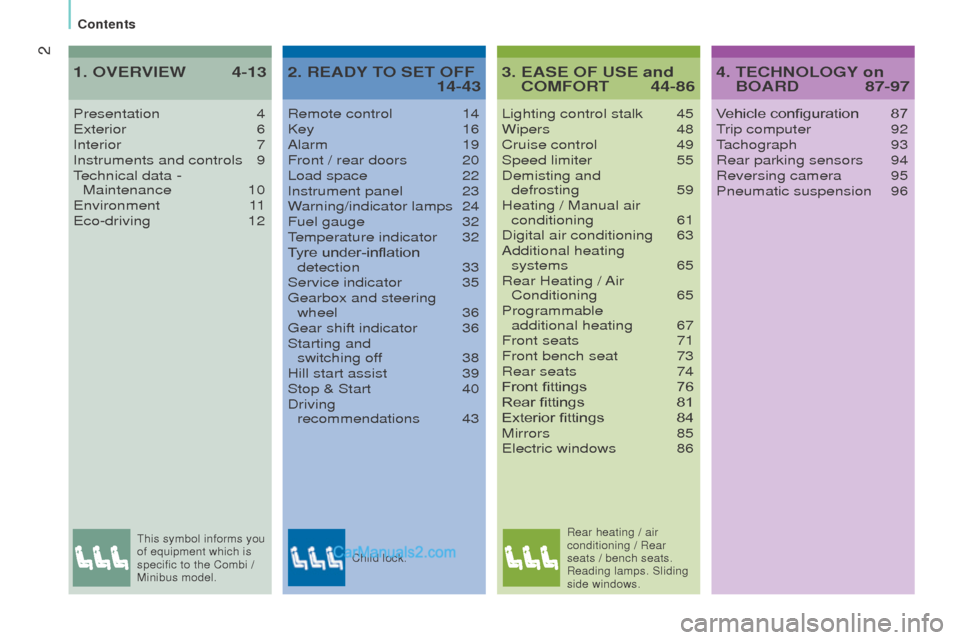
2
contents
3. EASE oF uSE and coMFort 44-86
Lighting control stalk 45
Wipers 48
Cruise control 49
Speed limiter 55
Demisting and defrosting
59
Heating / Manual air conditioning
61
Digital air conditioning 63
Additional heating systems
65
Rear Heating / Air Conditioning
65
Programmable additional heating
67
Front seats 71
Front bench seat 73
Rear seats 74
Front fittings 76
Rear fittings 81
Exterior fittings 84
Mirrors 85electric windows 86
Presentation
4exterior 6
Interior 7
Instruments and controls 9technical data - Maintenance 10environment 1
1
eco-driving 12
1. oVErVIEW 4-13 4. tEcHnoLoGY on
BoArd 87-97
Vehicle configuration 87trip computer 92tachograph 93
Rear parking sensors 94
Reversing camera 95
Pneumatic suspension 96
2. rEAdY to SEt oFF 14-43
Remote control 14
Key 16
Alarm 19
Front / rear doors 20
Load space 22
Instrument panel 23
Warning/indicator lamps 24
Fuel gauge 32temperature indicator 32
Tyre under-inflation detection
33
Service indicator 35gearbox and steering
wheel 36gear shift indicator 36
Starting and switching of
f
38
Hill start assist 39
Stop & Start 40
Driving recommendations
43
this symbol informs you
of equipment which is
specific to the Combi
/
Minibus model. Child lock.Rear heating / air
conditioning / Rear
seats / bench seats.
Reading lamps. Sliding
side windows.
Page 5 of 276
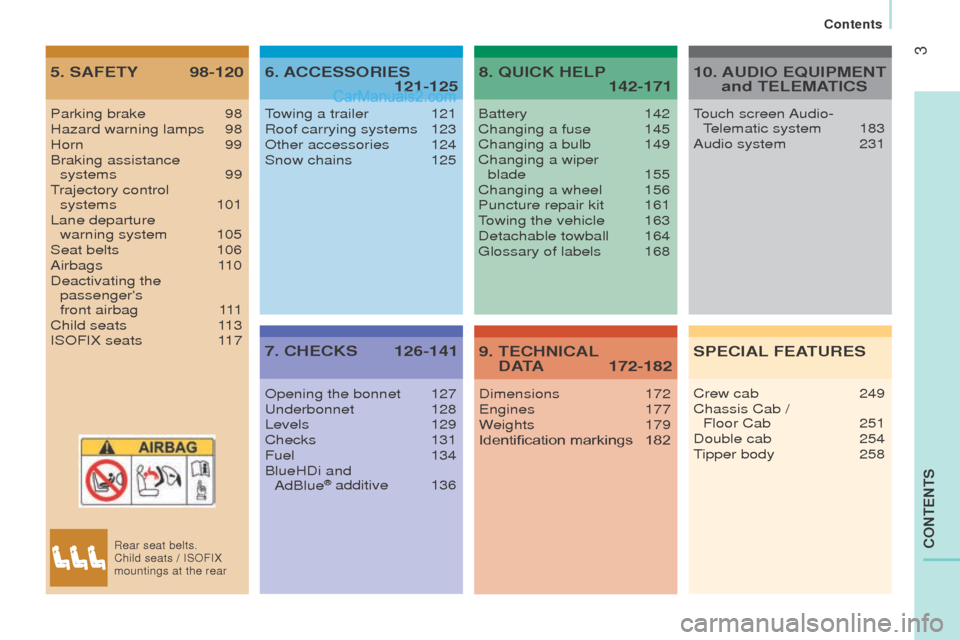
3
cont
Ent
S
5. SAFEtY 98-120 6. AccESSorIES 121-125
7.
cHEcKS 126-141 8.
QuIcK HELP
142-171
9.
tEcHnIcAL
dAtA 172-182
Parking brake 98
Hazard warning lamps 98
Horn 99
Braking assistance systems
99trajectory control systems 101
Lane departure warning system
105
Seat belts 106
Airbags 1
10
Deactivating the passenger's
front airbag
11
1
Child seats
113
ISOFIX seats 117
towing a trailer 121
Roof carrying systems 123
Other accessories 124
Snow chains 125
Opening the bonnet
127underbonnet 128
Levels 129
Checks 131
Fuel 134
BlueHDi and AdBlue
® additive 136 Battery
142
Changing a fuse 145
Changing a bulb 149
Changing a wiper blade
155
Changing a wheel 156
Puncture repair kit 161towing the vehicle 163
Detachable towball 164glossary of labels 168
Dimensions
172engines 177
W
eights
179
Identification markings 182
10. AudIo EQuIPMEnt
and tELEMAtIcS
SPE
cIAL
FEA
turES
touch screen Audio-telematic system 183
Audio system 231
Crew cab
249
Chassis Cab / Floor Cab
251
Double cab 254tipper body 258
Rear seat belts.
Child seats / ISOFIX
mountings at the rear
Contents
Page 8 of 276
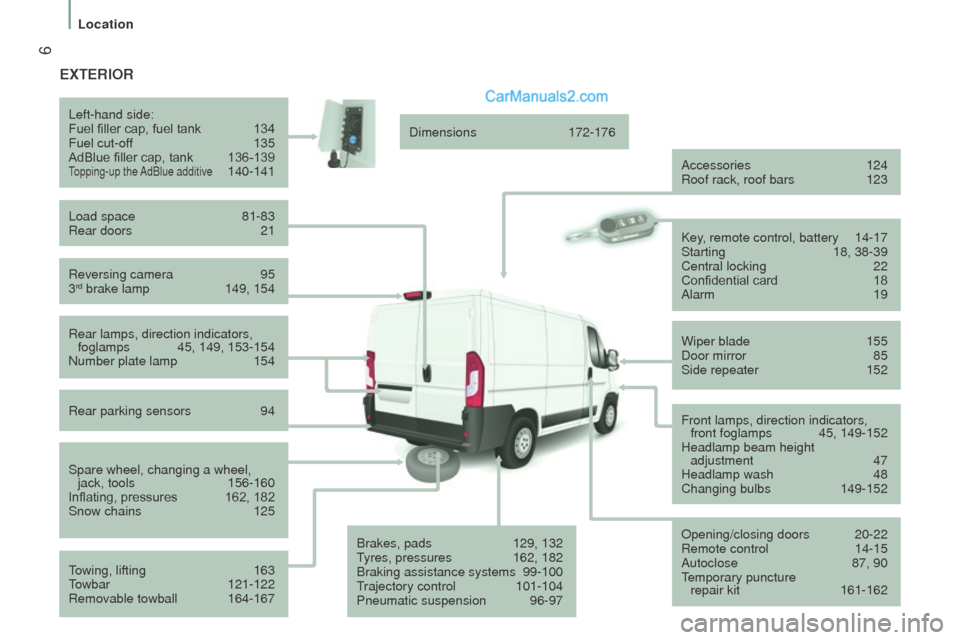
6
ExtErIor
Reversing camera 95
3rd brake lamp 149, 154
Left-hand side:
Fuel filler cap, fuel tank
134
Fuel cut-off 135
AdBlue filler cap, tank 136-139topping-up the AdBlue additive 140-141
Load space
81-83
Rear doors 21
Rear lamps, direction indicators, foglamps
45, 149, 153-154
Number plate lamp 154
Rear parking sensors
94
Spare wheel, changing a wheel, jack, tools
156-160
Inflating, pressures 162, 182
Snow chains 125
towing, lifting 163towbar 121-122
Removable towball 164-167 Dimensions
172-176
Accessories
124
Roof rack, roof bars 123
Brakes, pads
129, 132tyres, pressures 162, 182
Braking assistance systems 99-100trajectory control 101-104
Pneumatic suspension 96-97 Key, remote control, battery
14-17
Starting 18, 38-39
Central locking 22
Confidential card 18
Alarm 19
Wiper blade
155
Door mirror 85
Side repeater 152
Opening/closing doors
20-22
Remote control 14-15
Autoclose 87, 90temporary puncture repair kit 161-162
Front lamps, direction indicators,
front foglamps
45, 149-152
Headlamp beam height adjustment
47
Headlamp wash 48
Changing bulbs 149-152
ExtErIor
Location
Page 14 of 276
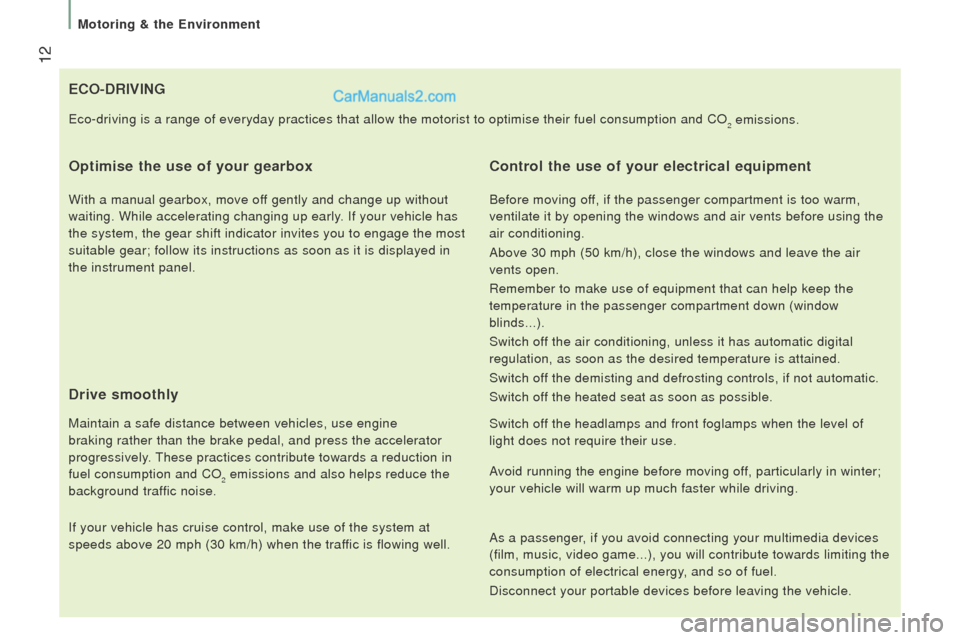
12
Eco-drIVInG
o
ptimise the use of your gearbox
With a manual gearbox, move off gently and change up without
waiting. While accelerating changing up early. If your vehicle has
the system, the gear shift indicator invites you to engage the most
suitable gear; follow its instructions as soon as it is displayed in
the instrument panel.
drive smoothly
Maintain a safe distance between vehicles, use engine
braking rather than the brake pedal, and press the accelerator
progressively.
these practices contribute towards a reduction in
fuel consumption and CO
2 emissions and also helps reduce the
background traffic noise.
If your vehicle has cruise control, make use of the system at
speeds above 20 mph (30 km/h) when the traffic is flowing well.
control the use of your electrical equipment
Before moving off, if the passenger compartment is too warm,
ventilate it by opening the windows and air vents before using the
air conditioning.
Above 30 mph (50 km/h), close the windows and leave the air
vents open.
Remember to make use of equipment that can help keep the
temperature in the passenger compartment down (window
blinds...).
Switch off the air conditioning, unless it has automatic digital
regulation, as soon as the desired temperature is attained.
Switch off the demisting and defrosting controls, if not automatic.
Switch off the heated seat as soon as possible.
Switch off the headlamps and front foglamps when the level of
light does not require their use.
eco-driving is a range of everyday practices that allow the motorist to o\
ptimise their fuel consumption and CO2 emissions.
Avoid running the engine before moving off, particularly in winter;
your vehicle will warm up much faster while driving.
As a passenger, if you avoid connecting your multimedia devices
(film, music, video game...), you will contribute towards limiting the\
consumption of electrical energy, and so of fuel.
Disconnect your portable devices before leaving the vehicle.
Motoring & the environment
Page 15 of 276
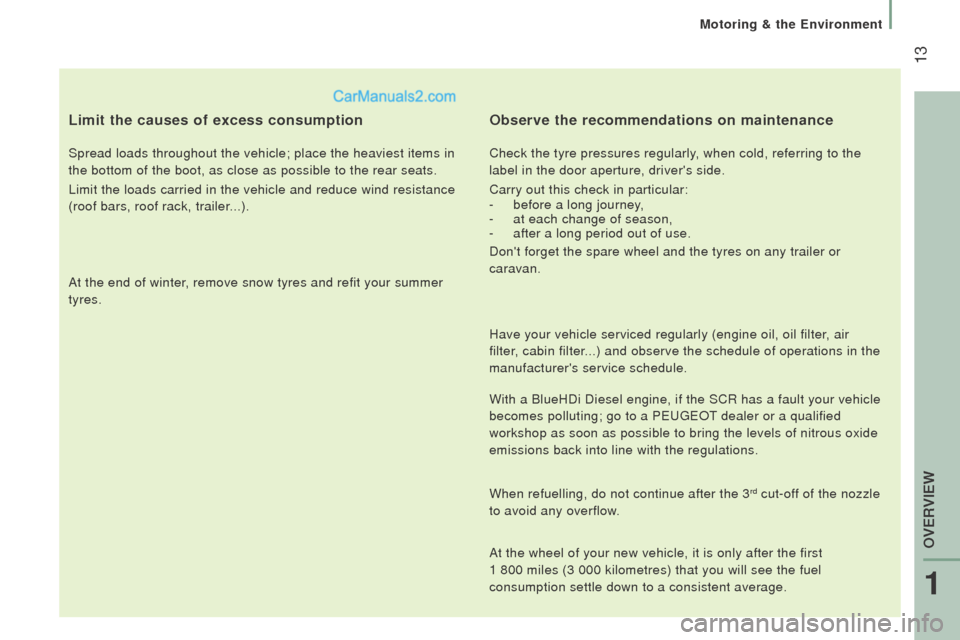
13
Limit the causes of excess consumption
Spread loads throughout the vehicle; place the heaviest items in
the bottom of the boot, as close as possible to the rear seats.
Limit the loads carried in the vehicle and reduce wind resistance
(roof bars, roof rack, trailer...).
At the end of winter, remove snow tyres and refit your summer
tyres.
observe the recommendations on maintenance
Check the tyre pressures regularly, when cold, referring to the
label in the door aperture, driver's side.
Carry out this check in particular:
-
before a long journey,
- at each change of season,
- after a long period out of use.
Don't forget the spare wheel and the tyres on any trailer or
caravan.
Have your vehicle serviced regularly (engine oil, oil filter
, air
filter, cabin filter...) and observe the schedule of operations in the
manufacturer's service schedule.
With a BlueHDi Diesel engine, if the SCR has a fault your vehicle
becomes polluting; go to a P
eugeOt dealer or a qualified
workshop as soon as possible to bring the levels of nitrous oxide
emissions back into line with the regulations.
When refuelling, do not continue after the 3
rd cut-off of the nozzle
to avoid any overflow.
At the wheel of your new vehicle, it is only after the first
1
800 miles (3 000 kilometres) that you will see the fuel
consumption settle down to a consistent average.
1
OVeRVIeW
Motoring & the environment
Page 18 of 276
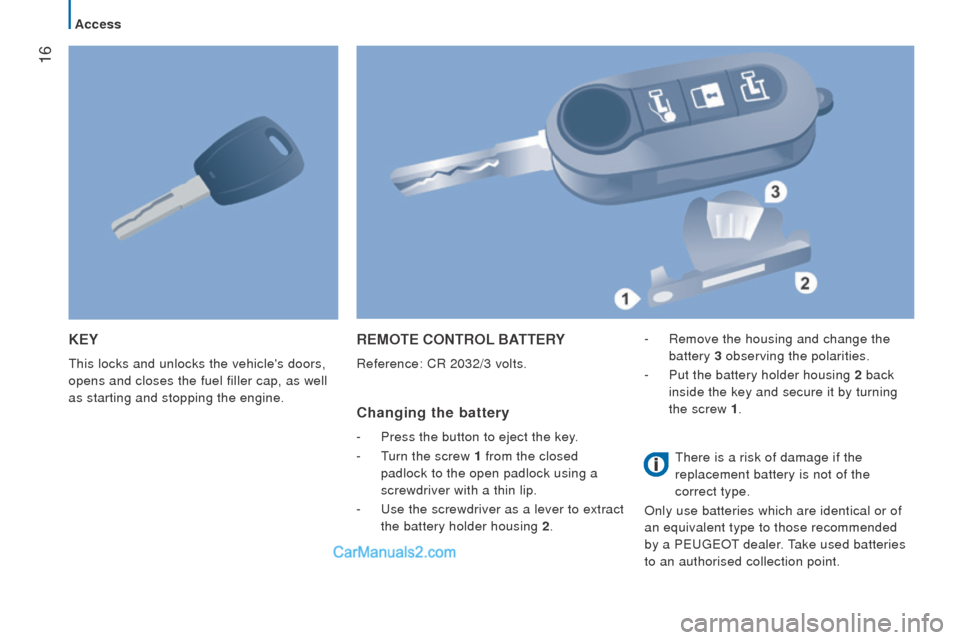
16
KEY
this locks and unlocks the vehicle's doors,
opens and closes the fuel filler cap, as well
as starting and stopping the engine.
rEMotE controL BAttErY
Reference: CR 2032/3 volts.
changing the battery
- Press the button to eject the key.
-
t
urn the screw 1 from the closed
padlock to the open padlock using a
screwdriver with a thin lip.
-
u
se the screwdriver as a lever to extract
the battery holder housing 2 .-
Remove the housing and change the
battery
3 observing the polarities.
-
Put the battery holder housing 2 back
inside the key and secure it by turning
the screw 1 .
there is a risk of damage if the
replacement battery is not of the
correct type.
Only use batteries which are identical or of
an equivalent type to those recommended
by a P
eugeOt dealer. take used batteries
to an authorised collection point.
Access
Page 25 of 276
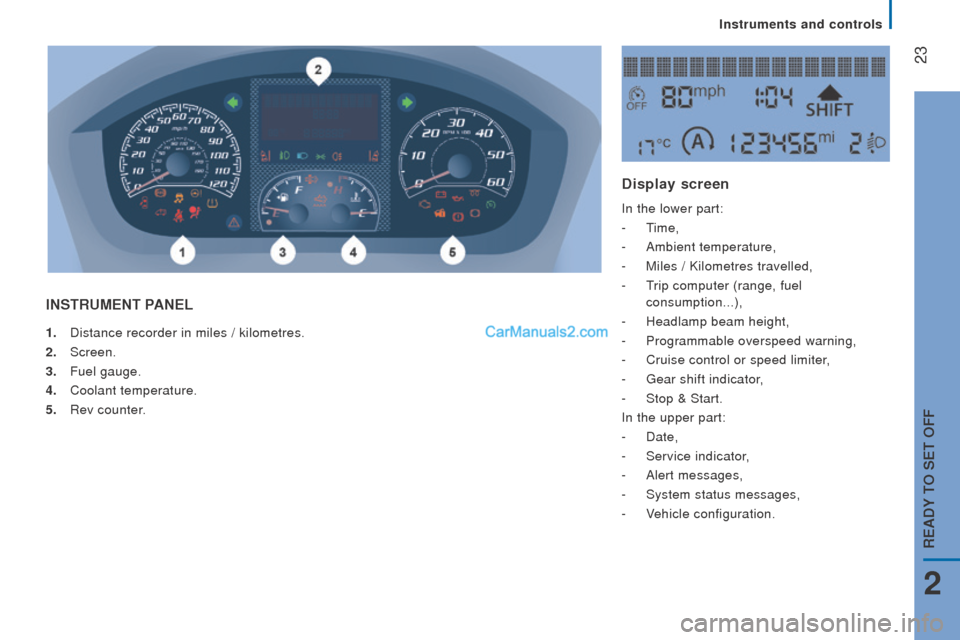
23
1. Distance recorder in miles / kilometres.
2.
Screen.
3.
Fuel gauge.
4.
Coolant temperature.
5.
Rev counter.
InStruMEnt PAnEL d
isplay screen
In the lower part:
-
time,
-
Ambient temperature,
-
Miles / Kilometres travelled,
-
t
rip computer (range, fuel
consumption...),
-
Headlamp beam height,
-
Programmable overspeed warning,
-
Cruise control or speed limiter,
-
g
ear shift indicator
,
-
Stop & Start.
In the upper part:
-
Date,
-
Service indicator,
-
Alert messages,
-
System status messages,
-
Vehicle configuration.
2
rEAdY to SEt oFF
Instruments and controls
Page 30 of 276
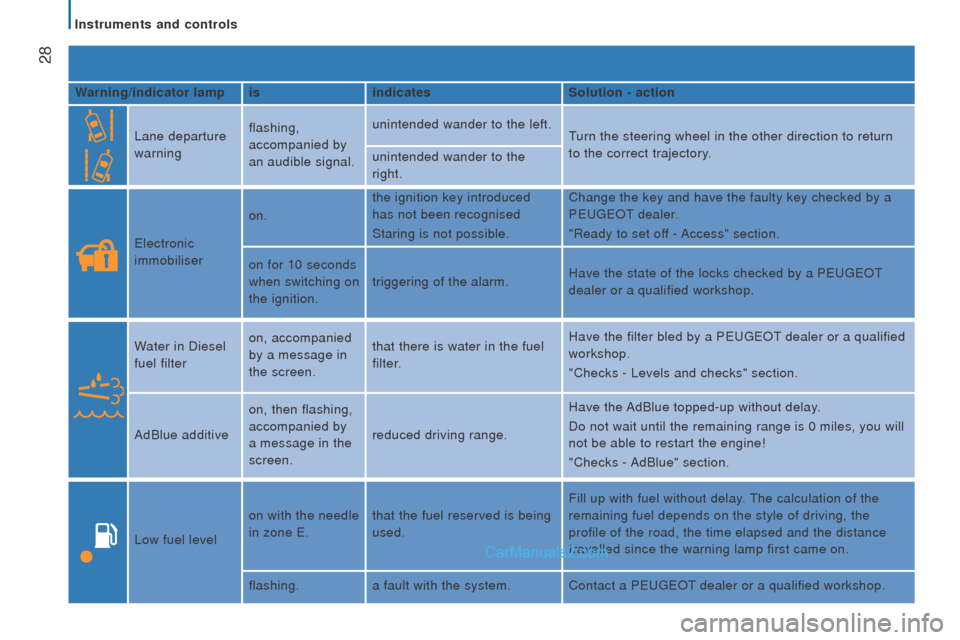
28
Warning/indicator lampisindicates Solution - action
Lane departure
warning flashing,
accompanied by
an audible signal. unintended wander to the left.
turn the steering wheel in the other direction to return
to the correct trajectory
.
unintended wander to the
right.
electronic
immobiliser on.
the ignition key introduced
has not been recognised
Staring is not possible. Change the key and have the faulty key checked by a
P
eugeOt dealer.
"Ready to set of
f - Access" section.
on for 10 seconds
when switching on
the ignition. triggering of the alarm.
Have the state of the locks checked by a P
eugeOt
dealer or a qualified workshop.
Water in Diesel
fuel filter on, accompanied
by a message in
the screen. that there is water in the fuel
filter. Have the filter bled by a P
eugeOt dealer or a qualified
workshop.
"Checks - Levels and checks" section.
AdBlue additive on, then flashing,
accompanied by
a message in the
screen. reduced driving range. Have the AdBlue topped-up without delay.
Do not wait until the remaining range is 0 miles, you will
not be able to restart the engine!
"Checks - AdBlue" section.
Low fuel level on with the needle
in zone
e.
that the fuel reserved is being
used. Fill up with fuel without delay.
the calculation of the
remaining fuel depends on the style of driving, the
profile of the road, the time elapsed and the distance
travelled since the warning lamp first came on.
flashing. a fault with the system. Contact a P
eugeOt dealer or a qualified workshop.
Instruments and controls